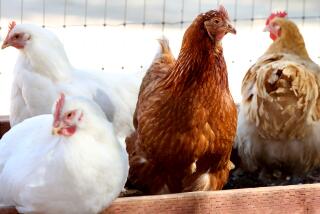Hong Kong to Extend Poultry Ban to Ensure Avian Virus Is Eradicated
- Share via
HONG KONG — Having determined that poultry farms in China are the “probable” source of a mysterious flu virus that has caused four human deaths here, Hong Kong authorities Tuesday said they would extend a ban on Chinese bird shipments and impose stringent quarantines and testing procedures before new imports will be permitted.
The strong measures, including increased patrols on both sides of the border to prevent smuggling, represent one of the first tests of Hong Kong’s “autonomous” status since the territory’s transfer from British to Chinese rule July 1.
Hong Kong officials are asking permission to inspect Chinese farms and certify their stocks before allowing exports to the territory.
In a news conference here Tuesday, senior Hong Kong health and agriculture officials said China is cooperating fully with the avian controls. “I must thank the mainland authorities for their cooperation,” said Stephen Ip, Hong Kong secretary for economic services. “They realize the importance of this.”
But the issue has a sensitive edge because Chinese agriculture officials have denied having any cases of the avian virus--H5N1 Type A influenza--in poultry stocks. Specifically, they have rejected reports by Hong Kong University microbiologists that in spring an outbreak of the flu virus occurred on farms in adjacent Guangdong province, killing more than 1 million birds.
“In our recent discussions,” said Lessie Wei, director of Hong Kong’s Agriculture and Fisheries Department, “they said they had some chickens die in April of Newcastle disease [an unrelated poultry ailment]. They also said they had cases of avian flu virus, but in 1994 and not the same H5N1 virus.”
Chinese officials also denied any cases of H5N1 virus infecting humans. In May, a 3-year-old Hong Kong boy died in the first recorded case of a human contracting the deadly H5N1 virus, previously thought to infect only poultry and wild fowl. Since then, another 19 confirmed and suspected human cases have been discovered here.
After a second “bird flu” death in early December, that of a 54-year-old man, the World Health Organization grew alarmed that the Hong Kong cases could represent the first virulent stage of a new flu pandemic similar to those that originated in China and Hong Kong in 1957 and 1968, killing tens of thousands of people worldwide.
Epidemiologists, including a team from the U.S. Centers for Disease Control and Prevention in Atlanta, say they have found no substantial evidence so far of human-to-human transmission of the disease, a key element in a flu pandemic.
But Hong Kong officials were so concerned by the situation that they took the unprecedented step Sunday of ordering the slaughter of all poultry in the territory, an estimated 1.3 million chickens, ducks, quail, partridge and geese on farms and in shops. Wei said Tuesday that she hoped the government-ordered slaughter would be completed by the end of the day.
However, underlying the concern here is that the extreme actions, which include cleansing and sterilizing all of Hong Kong’s many farms and poultry stalls, will have minimal results if the virus also exists on the mainland and officials there do not take similar steps.
According to Chinese media reports, the Ministry of Agriculture in Beijing said Tuesday that on Dec. 17 it had dispatched an investigative team into Guangdong province to inspect selected poultry farms.
Feng Jinglan, vice director of the Animal Husbandry and Health Department, said the team took blood from birds on 24 farms and in several markets, finding no H5N1 virus infections. Feng said the Agriculture Ministry was preparing a notice urging “the whole country, and coastal provinces in particular, to be alert for the bird flu which has been found among chickens in Hong Kong.”
But Hong Kong health officials said they ordered the poultry slaughter after infected birds, most from the mainland, were discovered last week at Cheung Sha Wan, Hong Kong’s biggest wholesale poultry market. This led the Hong Kong officials to conclude that the new outbreak probably involved mainland birds.
“There were some Hong Kong birds there also,” said Wei, “so I can only say that it is probable that the [infected] birds came from the mainland. But you can never be 100% sure.”
As a preventive measure, Hong Kong last week temporarily banned the import of live poultry from China, which averaged 75,000 birds a day.
On Tuesday, Ip said the territory was extending the ban and instituting several quarantine and testing procedures to prevent infected mainland poultry from entering Hong Kong. The procedures, Ip said, call for Hong Kong officials to inspect supplier farms on the mainland and work with authorities there to “standardize testing methods.”
Mainland farmers are likely to be required to quarantine birds destined for export to Hong Kong for five days and subject them to a test for the virus. At the border, Hong Kong authorities would inspect the certificates and take blood samples of the birds. Those found to be infected would be destroyed.
Ip said setting up the procedures could take months. Hong Kong’s ban on imports has already caused economic hardship in China, where officials say several poultry farms are near bankruptcy.
The bird kill has not extended to household pets--the canaries, finches and thrushes beloved by many. But officials say the public panic surrounding the bird flu has prompted some families to release their pets.
Hong Kong’s zoo and aviary exhibits have been unaffected.
Wei said efforts of the 1,000 workers to slaughter Hong Kong birds had been slowed because of the difficulty in locating some farms and the inexperience of some staff in catching chickens and slitting their throats.
Wei said workers involved in the slaughter included secretaries, park rangers and dog catchers. “I don’t know whether I am pleased to tell you this,” Wei said with a smile, “but some of my people are becoming quite efficient killers.”
More to Read
Sign up for Essential California
The most important California stories and recommendations in your inbox every morning.
You may occasionally receive promotional content from the Los Angeles Times.










